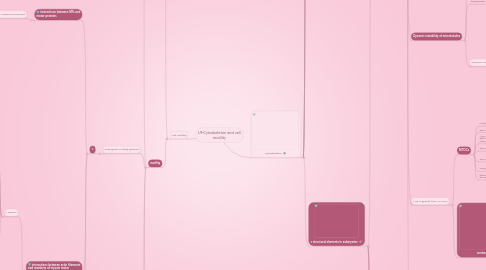
1. cell motility
1.1. involves
1.1.1. movement of a cell/organism throught the environment
1.1.2. movement of the environment past/through the cell
1.1.3. movement of cell components
1.1.3.1. movement of intracellular components
1.1.3.1.1. e.g. MTs of mitotic spindle play a role in separation of chromosome during anaphase
1.1.3.1.2. MTs and MFs provide a scaffold for motor proteins/mechanoenzymes
1.1.4. contractility
1.1.4.1. describes shortening of muscle cells
1.2. motility
1.2.1. occurs at the tissue,cellular and subcellular levels
1.2.2. eukaryotic motility systems
1.2.2.1. 2
1.2.2.1.1. interactions between MTs and motor proteins
1.2.2.1.2. interactions between actin filaments and members of myosin motor proteins
1.2.2.1.3. Kinesins vs Myosins
1.2.3. chemotaxis
1.2.3.1. cell moves in response to chemical gradient
1.2.3.2. chemoattractants
1.2.3.2.1. cells move towards a higher conc
1.2.3.3. chemorepellents
1.2.3.3.1. cells move towards lower conc.
1.2.4. Amoeboid movement
1.2.4.1. type of crawling exhibited by amoebas+WBCs
1.2.4.1.1. accompanied by protrusion of pseudopodia
1.2.4.2. pseudopodia
1.2.4.2.1. false foot
2. Cytoskeleton
2.1. a network of interconnected filament and tubules that extends throughout the cytosol
2.1.1. from nucleus>inner surface of PM
2.2. dynamic and changeable
2.3. altered by events at cell surface
2.3.1. participate in and modulate these events also
2.4. roles
2.4.1. cell movement and division
2.4.2. in eukaryotes
2.4.2.1. move membrane bound organelles within the cytosol
2.4.3. messenger RNA and other cellular components
2.4.4. cell signalling + cell-cell adhesion
2.5. technique used to visualize it
2.5.1. FM
2.5.1.1. on fixed specimens
2.5.1.1.1. fluorescent compounds directly bind to cytoskeletal proteins
2.5.2. Live cell FM
2.5.2.1. Fluorescent versions of cytoskeletal proteins made + introduced into living cells
2.5.2.1.1. FM + video/digital cameras used to view them as hey function in cells
2.5.3. computer enhanced digital video microscopy
2.5.3.1. High-resolution images from video/digital camera are computer processed to increase contrast and remove background features
2.5.4. EM
2.5.4.1. resolves individual filaments prepared by thin section,quick-freeze deep-etch, or direct-mount technique
2.6. similarities between eukaryotic and bacterial cytoskeletal systems
2.6.1. rod-shaped bacteria and Archaea have polymer systems that function in a similar way to MTs,MFs,IFs
2.6.1.1. MreB protein
2.6.1.1.1. actin like
2.6.1.1.2. involved in DNA segregation
2.6.1.2. FtsZ protein
2.6.1.2.1. tubulin like
2.6.1.2.2. involved in determining where bacterial cells divide
2.6.1.2.3. produced by certain organelles in eukaryotes
2.6.1.3. crescentin protein
2.6.1.3.1. IFs like
2.6.1.3.2. important regulator of cell shape
2.6.2. at amino acid level
2.6.2.1. bacterial proteins + eukaryotic proteins not similar
2.6.3. at polymer level
2.6.3.1. Xray crystallography showed that they are similar when assembled into polymers
2.6.4. biochemical level
2.6.4.1. proteins from both bacteria+eukaryotes bind same phospho nucleotides
2.7. 3 structural elements in eukaryotes
2.7.1. microtubules
2.7.1.1. MTs
2.7.1.2. largest of the cytoskeletal elements
2.7.1.3. structure
2.7.1.3.1. straight hollow cylinders
2.7.1.3.2. vary greatly in length
2.7.1.4. formation of MTs
2.7.1.4.1. by addition of tubulin heterodimers at their ends
2.7.1.4.2. measured by spectrophotometer
2.7.1.4.3. MT growth depends on conc. of tubulin dimers
2.7.1.4.4. MT growth rate different at both ends
2.7.1.4.5. treadmilling
2.7.1.4.6. affect of drugs on MT formation
2.7.1.5. classified into 2 grps
2.7.1.5.1. differ in degree of organization & structural ability
2.7.1.5.2. cytoplasmic MTs
2.7.1.5.3. axonemal MTs
2.7.1.6. subunits
2.7.1.6.1. composed of tubulin
2.7.1.7. diameter
2.7.1.7.1. outer 25nm
2.7.1.7.2. inner 15nm
2.7.1.8. polar
2.7.1.8.1. +ve and -ve end
2.7.1.9. functions
2.7.1.9.1. cytoplasmic
2.7.1.9.2. Axonemal
2.7.1.10. Dynamic instability of microtubules
2.7.1.10.1. role of GTP
2.7.1.10.2. some microtubules can grow by polymerization at the same time as others are shrinking by depolymerzation
2.7.1.10.3. Dynamic instability model
2.7.1.11. MTs originate from MTOCs
2.7.1.11.1. MTOCs
2.7.1.11.2. centrosomes
2.7.1.12. Microtubule binding proteins(regulation)
2.7.1.12.1. used by cells to regulate MT stability
2.7.1.12.2. 2 types
2.7.2. microfilaments
2.7.2.1. MFs
2.7.2.2. smallest of cytoskeletal filaments
2.7.2.3. occur in almost all eukaryotic cells
2.7.2.4. structure
2.7.2.4.1. two intertwined chains of F-actin
2.7.2.5. subunits
2.7.2.5.1. polymers of the protein actin
2.7.2.6. Formation
2.7.2.6.1. G-actin monomers polymerize reversibly into filaments
2.7.2.6.2. more rapid elongation phase
2.7.2.6.3. F-actin
2.7.2.6.4. depends on conc. of ATP-bound G-actin
2.7.2.7. Actin-binding proteins involved in regulation
2.7.2.7.1. monomer-binding proteins
2.7.2.7.2. capping proteins
2.7.2.8. Drugs that affect formation
2.7.2.8.1. Cytochalasins
2.7.2.8.2. Latrunculin A
2.7.2.8.3. Phalloidin
2.7.2.9. diameter
2.7.2.9.1. 7nm
2.7.2.10. polar
2.7.2.10.1. +ve and -ve ends
2.7.2.10.2. all actin monomers in actin filament are oriented in the same direction
2.7.2.11. Function
2.7.2.11.1. muscle contraction
2.7.2.11.2. cell locomotion
2.7.2.11.3. cytoplasmic streaming
2.7.2.11.4. cytokenesis
2.7.2.11.5. development + maintenance of animal shape
2.7.2.11.6. intracellular transport/trafficking
2.7.3. intermediate filaments
2.7.3.1. IFs
2.7.3.2. e.g keratin
2.7.3.3. most stable
2.7.3.3.1. most likely to remain when cells are treated with solutions of nonionic detergants/ solutions of high ionic strenght
2.7.3.4. least soluble
2.7.3.5. subunits
2.7.3.5.1. depend on cell type
2.7.3.6. formation
2.7.3.6.1. pair of intermediate filament polypeptides
2.7.3.6.2. two polypeptides twist around each other to form coiled coil(dimer)
2.7.3.6.3. two dimers align to form tetrameric protofilament
2.7.3.6.4. protofilaments assemble into larger filaments by end to end and side to side allignment
2.7.3.6.5. fully assembled IF is made up of 8 protofilaments
2.7.3.7. structure
2.7.3.7.1. eight protofilaments joined end to end with staggered overlap
2.7.3.7.2. all IFs are fibrous proteins
2.7.3.7.3. all have a central homologous domain
2.7.3.8. diameter
2.7.3.8.1. 8-12nm
2.7.3.9. function
2.7.3.9.1. structural support
2.7.3.9.2. maintenance of animal cell shape
2.7.3.9.3. formation of nuclear lamina and scaffolding
2.7.3.9.4. strengthening of nerve cell axons
2.7.3.9.5. keeping muscle fibers in register
2.7.3.10. no polarity
2.7.3.11. 6 classes
2.7.3.11.1. class I and II
2.7.3.11.2. class III
2.7.3.11.3. class 4
2.7.3.11.4. class 5
2.7.3.11.5. class 6
2.7.4. first revealed by EM
2.7.5. each system has distinctive associated proteins
2.7.5.1. identified by biochemical studies
2.7.5.1.1. e.g. indirect immunostaining
2.7.5.2. accessory proteins
2.7.5.2.1. proteins associated with cytoskeletal filaments
2.7.5.2.2. account for remarkable structural and functional diversity of cytoskeletal elements
2.7.6. IFs ,MTs and MFs are interconnected within cells to form cyoskeletal networks that can withstand tension,compresioon, providing mechanical strength and rigidity to cells
2.7.6.1. made possible by linker proteins called plakins
2.7.6.1.1. plakins plural
2.7.6.1.2. singular plectin
2.7.6.1.3. versatile linker proteins that are found where IFs are connected to MFs/Mts
2.7.6.1.4. help to integrate MFs and MTs into a mechanically integrated cystoskeletal network

